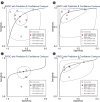Role of D-dimer and Fibrinogen in the Diagnosis of Periprosthetic Joint Infection: A Systematic Review and Meta-Analysis
- PMID: 33682337
- PMCID: PMC8126916
- DOI: 10.1111/os.12969
Role of D-dimer and Fibrinogen in the Diagnosis of Periprosthetic Joint Infection: A Systematic Review and Meta-Analysis
Abstract
The diagnostic potential of D-dimer and fibrinogen to detect periprosthetic joint infection (PJI) of the hip and knee is not well-understood. The aim of this study was to determine whether D-Dimer and fibrinogen can be used as effective biomarkers to screen PJI. A systematic review of the literature indexed in Web of Science, PubMed, Cochrane Library, Embase, and Google Scholar databases was performed. All studies using D-dimer levels in serum or plasma, or fibrinogen levels in plasma, for the diagnosis of PJI were included. Meta-analysis estimates, including sensitivity, specificity, diagnostic odds ratios (DOR), and the area under the summary receiver operating characteristic curve (AUSROC), were calculated using a random-effects model, and used to assess the diagnostic accuracy of these biomarkers. A total of nine studies were analyzed, and their quality was considered to be acceptable. D-dimer gave a limited diagnostic value if serum and plasma combined: sensitivity (0.77, 95% confidence interval [CI] [0.63 to 0.87]), specificity (0.67, 95% CI [0.54 to 0.78]), DOR (6.81, 95% CI [2.67 to 17.37]), and AUSROC (0.78, 95% CI [0.74 to 0.82]). Plasma D-dimer levels were associated with less satisfactory sensitivity (0.65, 95% CI 0.57 to 0.71), specificity (0.58, 95% CI 0.50 to 0.66), DOR (2.52, 95% CI 1.64 to 3.90), and AUSROC (0.65, 95% CI 0.61 to 0.69). Serum D-dimer levels showed higher corresponding values of 0.89 (95% CI 0.79 to 0.94), 0.76 (95% CI 0.55 to 0.89), 24.24 (95% CI 10.07 to 58.32), and 0.91 (95% CI 0.88 to 0.93). Plasma fibrinogen showed acceptable corresponding values of 0.79 (95% CI 0.70 to 0.85), 0.73 (95% CI 0.57 to 0.85), 10.14 (95% CI 6.16 to 16.70), and 0.83 (95% CI 0.79 to 0.86). Serum D-dimer may be an effective marker for the diagnosis of PJI in hip and knee arthroplasty patients, and it may show higher diagnostic potential than plasma fibrinogen. Plasma D-dimer may have limited diagnostic potential.
Keywords: D-dimer; Fibrinogen; Meta-analysis; Periprosthetic joint infection; Plasma; Serum.
© 2021 The Authors. Orthopaedic Surgery published by Chinese Orthopaedic Association and John Wiley & Sons Australia, Ltd.
Figures



Similar articles
-
Plasma Fibrinogen Exhibits Better Performance Than Plasma D-Dimer in the Diagnosis of Periprosthetic Joint Infection: A Multicenter Retrospective Study.J Bone Joint Surg Am. 2019 Apr 3;101(7):613-619. doi: 10.2106/JBJS.18.00624. J Bone Joint Surg Am. 2019. PMID: 30946195
-
Diagnostic accuracy of D-dimer in periprosthetic joint infection: a diagnostic meta-analysis.J Orthop Surg Res. 2020 Aug 17;15(1):334. doi: 10.1186/s13018-020-01853-w. J Orthop Surg Res. 2020. PMID: 32807236 Free PMC article.
-
Unreliability of Serum- or Plasma-based Assays of D-dimer or Fibrin (Fibrinogen) Degradation Product for Diagnosing Periprosthetic Joint Infection: A Prospective Parallel Study.Orthop Surg. 2024 Jan;16(1):29-37. doi: 10.1111/os.13935. Epub 2023 Nov 17. Orthop Surg. 2024. PMID: 37975182 Free PMC article.
-
[Diagnostic value of D-dimer for chronic periprosthetic infection after hip and knee joint replacement].Zhonghua Wai Ke Za Zhi. 2020 Jun 1;58(6):464-468. doi: 10.3760/cma.j.cn112139-20191106-00550. Zhonghua Wai Ke Za Zhi. 2020. PMID: 32498487 Chinese.
-
D-dimer in the diagnosis of periprosthetic joint infection: a systematic review and meta-analysis.J Orthop Surg Res. 2020 Jul 16;15(1):265. doi: 10.1186/s13018-020-01761-z. J Orthop Surg Res. 2020. PMID: 32677991 Free PMC article.
Cited by
-
Role of Biomarkers in Periprosthetic Joint Infections.Diagnostics (Basel). 2022 Nov 25;12(12):2958. doi: 10.3390/diagnostics12122958. Diagnostics (Basel). 2022. PMID: 36552965 Free PMC article. Review.
-
Diagnostic value of platelet indices in infected nonunion: a retrospective study.J Orthop Surg Res. 2022 Apr 4;17(1):200. doi: 10.1186/s13018-022-03096-3. J Orthop Surg Res. 2022. PMID: 35379285 Free PMC article.
-
Limited value of coagulation parameters in diagnosing periprosthetic joint infection.Int Orthop. 2022 Oct;46(10):2189-2194. doi: 10.1007/s00264-022-05495-x. Epub 2022 Jul 5. Int Orthop. 2022. PMID: 35790548
-
Diagnosis of Periprosthetic Joint Infection: The Utility of Biomarkers in 2023.Antibiotics (Basel). 2023 Jun 15;12(6):1054. doi: 10.3390/antibiotics12061054. Antibiotics (Basel). 2023. PMID: 37370373 Free PMC article. Review.
-
Periprosthetic joint infections: state-of-the-art.Arch Orthop Trauma Surg. 2024 Dec 18;145(1):58. doi: 10.1007/s00402-024-05627-5. Arch Orthop Trauma Surg. 2024. PMID: 39694911 Review.
References
-
- Pivec R, Johnson AJ, Mears SC, Mont MA. Hip arthroplasty. Lancet, 2012, 380: 1768–1777. - PubMed
-
- Alipour M, Tabari M, Keramati M, Zarmehri AM, Makhmalbaf H. Effectiveness of oral tranexamic acid administration on blood loss after knee artroplasty: a randomized clinical trial. Transfus Apher Sci, 2013, 49: 574–577. - PubMed
-
- Parvizi J, Shohat N, Gehrke T. Prevention of periprosthetic joint infection: new guidelines. Bone Joint J, 2017, 99: 3–10. - PubMed
-
- Cozzi Lepri A, del Prete A, Soderi S, et al. The identification of pathogens associated with periprosthetic joint infection in two‐stage revision. Eur Rev Med Pharmacol Sci, 2019, 23: 101–116. - PubMed
-
- Saleh A, Ramanathan D, Siqueira MBP, Klika AK, Barsoum WK, Rueda CAH. The diagnostic utility of synovial fluid markers in periprosthetic joint infection: a systematic review and meta‐analysis. J Am Acad Orthop Surg, 2017, 25: 763–772. - PubMed
Publication types
MeSH terms
Substances
LinkOut - more resources
Full Text Sources
Other Literature Sources
Medical

